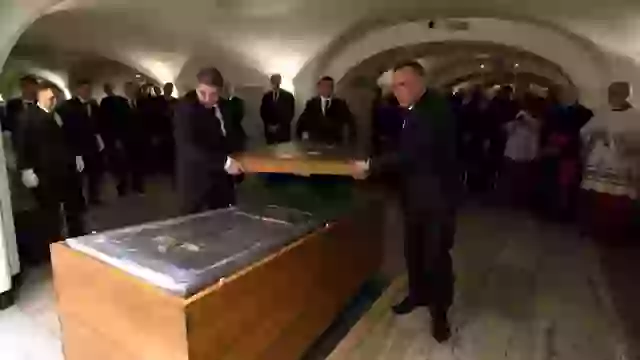The details surrounding the late Pope Francis’ funeral have been revealed, following his death at the age of 88.
The head of the Catholic Church passed away on Easter Monday (21 April), with his death announced by the Vatican.
His cause of death has since been revealed as a cerebral stroke that led to a coma and irreversible heart failure.
Today (22 April) it has been announced that Pope Francis’ funeral will take place on Saturday (26 April) with world leaders from across the globe set to gather to celebrate his life.
Following his death, it has now been revealed what the late Pope wanted for his burial according to a final testament released by the Vatican.
While previous pontiffs have been buried in coffins made of cypress, lead and oak, it’s reported that Pope Francis’ coffin will simply be made from wood and lined with zinc, as per his request.
According to Crisis magazine, zinc is used in coffins as a cost-effective way to aid the longevity of a body.
Meanwhile, according to Steve Soult Limited coffin manufacturers – who shared a video on the topic on TikTok – there’s a very touching reason why zinc is used to line caskets.
Alongside a clip explaining why zinc is added to the interiors of coffins, they wrote: “Zinc liners provide an added layer of protection against external factors such as water, insects, and other natural elements.
“By safeguarding the coffin, these liners ensure that the memory of our loved ones remains undisturbed, allowing us to find solace in knowing that their resting place will endure the test of time.”
They also added: “The zinc liner slows the process and aids the body to deteriorate in a more natural way from the exterior elements of the coffin in the ground.”

Before he died, Pope Francis mapped out his wishes for a ‘simple’ tomb ‘in the ground’ bearing only the inscription ‘Franciscus’ – an ode to his papal name which is in honour of St Francis of Assisi, who was also praised for his progressive attitude and humility.
The late Pope Francis’ final testament, which was signed 29 June 2022, reads in full:
“As I sense the approaching twilight of my earthly life, and with firm hope in eternal life, I wish to set out my final wishes solely regarding the place of my burial.
“Throughout my life, and during my ministry as a priest and bishop, I have always entrusted myself to the Mother of Our Lord, the Blessed Virgin Mary. For this reason, I ask that my mortal remains rest – awaiting the day of the Resurrection – in the Papal Basilica of Saint Mary Major.
“I wish my final earthly journey to end precisely in this ancient Marian sanctuary, where I would always stop to pray at the beginning and end of every Apostolic Journey, confidently entrusting my intentions to the Immaculate Mother, and giving thanks for her gentle and maternal care.”
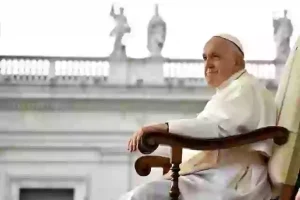
It continued: “I ask that my tomb be prepared in the burial niche in the side aisle between the Pauline Chapel (Chapel of the Salus Populi Romani) and the Sforza Chapel of the Basilica, as shown in the attached plan.
“The tomb should be in the ground; simple, without particular ornamentation, bearing only the inscription: Franciscus.
“The cost of preparing the burial will be covered by a sum provided by a benefactor, which I have arranged to be transferred to the Papal Basilica of Saint Mary Major.
“I have given the necessary instructions regarding this to Cardinal Rolandas Makrickas, Extraordinary Commissioner of the Liberian Basilica.
“May the Lord grant a fitting reward to all those who have loved me and who continue to pray for me.
“The suffering that has marked the final part of my life, I offer to the Lord, for peace in the world and for fraternity among peoples.”
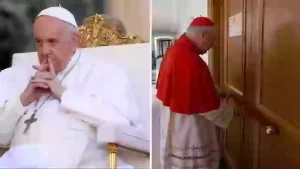
Reason why Pope Francis’ apartment is sealed with wax as coffin plans are revealed
Following Pope Francis’ death earlier this week, the pontiff’s apartment was sealed with red ribbon and wax, as per tradition – but why?
Pope Francis passed away on Easter Monday (21 April) at the age of 88 following his hospitalisation with double pneumonia earlier this year.
Cardinal Kevin Farrell said in a statement that ‘the Bishop of Rome, Francis’ had ‘returned to the home of the Father’, adding: “He taught us to live the values of the Gospel with faithfulness, courage, and universal love, especially for the poorest and most marginalised.”
The Vatican announced the Pope’s passing, and his cause of death has since been revealed as a cerebral stroke that led to a coma and irreversible heart failure.
Following his passing, a series of protocols have been implemented, including sealing the pontiff’s apartment after death.
The tradition is part of the ‘sede vacante’ or ‘vacant see’ which refers to the period between the death of a pope and the electing of his successor.
Cardinal Kevin Farrell, Cardinal Pietro Parolin and Archbishop Edgar Peña Parra all sealed the door of Pope Francis’ apartment in the Vatican.
The door is first taped, before being stamped and impressed with Francis’ papal seal.
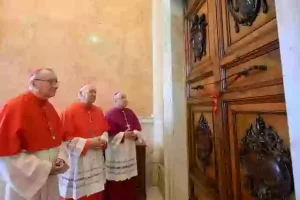
Finally, red ribbon is tied around the door handles and a wax seal is added to ensure no looting takes place, Sky reports.
The officials could be seen draping the ribbon through the handles and sealing it with wax, before they each checked if the door had been locked.
On Tuesday (22 April) it was announced that Pope Francis’ funeral will take place on Saturday (26 April) with world leaders from across the globe set to gather to celebrate his life.
Following his death, it has now been revealed what the late Pope wanted for his burial according to a final testament released by the Vatican.
While previous pontiffs have been buried in coffins made of cypress, lead and oak, it’s reported that Pope Francis’ coffin will simply be made from wood and lined with zinc, as per his request.
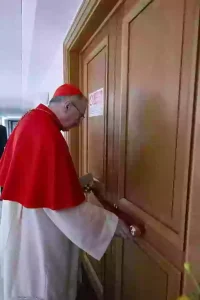
According to Crisis magazine, zinc is used in coffins as a cost-effective way to aid the longevity of a body.
Meanwhile, according to Steve Soult Limited coffin manufacturers – who shared a video on the topic on TikTok – there’s a very touching reason why zinc is used to line caskets.
Alongside a clip explaining why zinc is added to the interiors of coffins, they wrote: “Zinc liners provide an added layer of protection against external factors such as water, insects, and other natural elements.
“By safeguarding the coffin, these liners ensure that the memory of our loved ones remains undisturbed, allowing us to find solace in knowing that their resting place will endure the test of time.”
They also added: “The zinc liner slows the process and aids the body to deteriorate in a more natural way from the exterior elements of the coffin in the ground.”
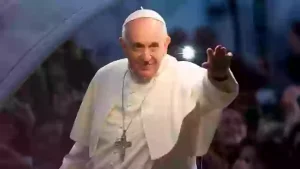
Why Pope Francis won’t be buried in the Vatican as major tradition is broken
It was announced by the Vatican earlier this morning (21 April) that Pope Francis passed away, but there is a reason as to why he won’t be buried in the Vatican – something which breaks a major long-running tradition.
Vatican camerlengo Cardinal Kevin Farrell announced the news in an official statement which confirmed that, at 7.35am this morning, the Bishop of Rome ‘returned to the home of the Father’.
“His entire life was dedicated to the service of the Lord and of his Church,” the statement continued. “He taught us to live the values of the Gospel with faithfulness, courage, and universal love, especially for the poorest and most marginalised.
“With immense gratitude for his example as a true disciple of the Lord Jesus, we commend the soul of Pope Francis to the infinite, merciful love of God, One and Tribune.”
Tributes for the late 88-year-old across the globe have since poured in including from King Charles III and JD Vance and, now that Pope Francis’ death has been confirmed and the nine days of mourning is set to commence, the church will enact a series of rituals before a successor is eventually chosen.
Now, unlike his many predecessors, Francis had previously said that he would not be laid to rest in the crypt of St. Peter’s Basilica in the Vatican City, but in the Basilica of Santa Maria Maggiore on the other side of the River Tiber in Rome.
He also asked to be buried in a simple wooden casket.
This makes the late Pope the first one in over a century to be buried outside the Vatican as, while several other popes have been laid to rest in Santa Maria Maggiore, Francis will be the first since Leo XIII, who died in 1903, not to be buried in St. Peter’s Basilica.
Francis revealed his plans to break the major tradition in December of 2023, explaining that he felt a ‘very strong connection’ with the basilica, which he used to visit on Sunday mornings to honour the Virgin Mary.
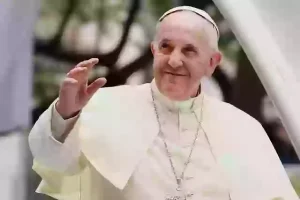
“I want to be buried in Santa Maria Maggiore,” he previously said. “Because it is my great devotion.”
On Easter Sunday (20 April), Francis attended his last public appearance on the balcony of St Peter’s Basilica, where he gave the attendees a heartfelt speech.
His message was one of peace and ‘respect for the views of others’.
Reading on his behalf, an aide said: “There can be no peace without freedom of religion, freedom of thought, freedom of expression.”
He continued to mention the people who have died in Gaza, with a particular focus on the Christians there, where he further noted that the conflict ’causes death and destruction’ and creates a ‘deplorable humanitarian situation’.
“What a great thirst for death, for killing we see in the many conflicts raging in different parts of the world,” he said.
Pope Francis extended his sympathy for ‘all the Israeli people and the Palestinian people’ and also urged for a ceasefire, adding: “Call a ceasefire, release the hostages and come to the aid of a starving people that aspires to a future of peace.”

Rules surrounding who can become the next pope as reason why it will never be a woman is revealed
With Pope Francis’ funeral taking place this Saturday (26 April), thoughts will inevitably turn to choosing his successor, and there are a series of strict rules around who can be chosen as the new pope.
Camerlengo Kevin Farrell announced the Pope’s death on Monday (21 April), and following a nine-day period of mourning that will begin after Francis’ funeral, 135 cardinal electors will gather in the Vatican to elect a new pope.
The top secret process is called a conclave, in which the voting cardinals are sequestered in the Sistine chapel and the doors are locked behind them.
The cardinals vote until one candidate gets a two-thirds majority, after which white smoke rises from the chimney of the Sistine Chapel and a new pope is announced.
The longest conclave of the 20th century was five days in 1922, but back in 1268 a conclave lasted a whopping two years and nine months. Some conclaves last just one day.
But who is and isn’t eligible for the highest office in the Catholic church?
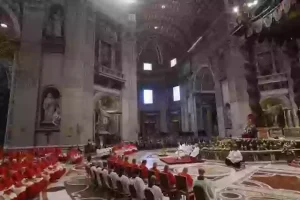
Why can’t a woman be pope?
There is no Biblical doctrine stating that women can’t be pope, but Catholics argue that precedent suggests popes must be men.
This is because Jesus chose 12 men to be his disciples, who in turn chose men to take over from them in leading the church.
Michele Dillon, a sociologist at the University of New Hampshire, told NBC: “Even if the current pope was the most feminist person you could meet and believes women should be priests, they want to be faithful to what they see as Jesus’s intentions.”
What are the requirements to be pope?
The requirements to become pope are incredibly simple – you have to be a baptised Catholic and you have to be male.
The pope doesn’t have to be a cardinal, although since it’s cardinals voting they have chosen from among their number for the last 500 years.
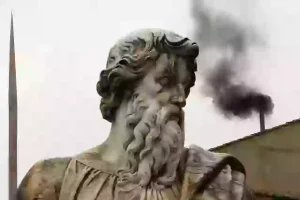
The pope doesn’t even have to be a priest – with Pope Leo X being the last non-priest Pope to be elected in 1513. He was quickly ordained as a priest and then consecrated as bishop before being crowned as pope.
Who are the favourites to become the next pope?
According to Reuters, the cardinals most likely to becomes the next pope include Frenchman Jean-Marc Aveline, 66; Hungarian cardinal Peter Erdo, 72; Maltese cardinal Mario Grech, 68; Spanish cardinal Juan Jose Omella, 79; Italian cardinal Pietro Parolin, 70; Filipino cardinal Luis Antonio Gokim Tagle, 67; US cardinal Joseph Tobin; Ghanaian cardinal Peter Kodwo Appiah Turkson, 76; and Italian archbishop Matteo Maria Zuppi, 69,
